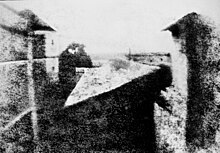Heliografia
Heliografia (ransk. héliographie, aurinkopiirros) on ranskalaisen keksijän Joseph Nicéphore Niépcen kehittämä maailman ensimmäinen menetelmä pysyvän valokuvan luomiseksi[1]. Niépce otti vanhimman säilyneen valokuvan, Näkymä ikkunasta Le Grasissa, vuonna 1826 käyttäen camera obscuraa ja 25,8 × 29 cm:n kokoista öljykäsiteltyä bitumilla pinnoitettua tinalevyä. Kun levy huuhdeltiin laventeliöljyllä, ainoastaan auringonvalosta kovettunut osa, itse kuva, jäi jäljelle. Ensimmäisen säilyneen kuvan valottamiseen meni kahdeksan tuntia, minkä vuoksi aurinko paistaa kuvassa molemmista suunnista, ja varjot heittyvät kahteen suuntaan.[2]

Niépce oli askarrellut valokuvauksen parissa jo vuodesta 1816 kokeillen erilaisia valonherkkiä kemikaaleja. Näiden varhaisten kokeiluiden tulokset eivät olleet pysyviä, sillä hän ei onnistunut kuvan kiinnittämisessä, joten kuvat haalistuivat nopeasti häviten näkyvistä.[3]
Niépcen kuoltua 1833 hänen työtään jatkoi Louis Daguerre, joka 1839 julkaisi heliografiaan ja Niépcen havaintoihin perustuvan, mutta huomattavasti kehittyneemmän dagerrotypian[4].
Lähteet muokkaa
- ↑ Harry Ransom Center, University of Texas, Austin: The First Photograph - Heliography, haettu 17.10.2008 (Arkistoitu – Internet Archive) "The term "heliography" was first coined by its inventor, Joseph Nicéphore Niépce, to identify the process by which he obtained the first permanent photographic images."
- ↑ Harry Ransom Center, University of Texas, Austin: The First Photograph - Overview, haettu 16.10.2008 "After at least a day-long exposure of eight hours, the plate was removed and the latent image of the view from the window was rendered visible by washing it with a mixture of oil of lavender and white petroleum which dissolved away the parts of the bitumen which had not been hardened by light."
- ↑ Harry Ransom Center, University of Texas, Austin: A Chronology - Joseph Nicéphore Niépce and the First Photograph, haettu 17.10.2008 (Arkistoitu – Internet Archive) "1816 - His first documented experiments of what could be termed a "photographic" nature. The use of a camera together with silver chloride on paper produces a negative image but he is unable to fix it in order to stop it from fading."
- ↑ Harry Ransom Center, University of Texas, Austin: The First Photograph - Heliography, haettu 17.10.2008 (Arkistoitu – Internet Archive) "Joined in partnership with Louis Jacques Mandé Daguerre in 1829, Niépce did little more with the heliograph. Upon his death in 1833, his son Isidore would take his place in the partnership but no further improvements in the process were forthcoming. By the time of their public announcement in 1839, Daguerre and his daguerreotype process far outshone his associate's pioneering contribution to photography."
Aiheesta muualla muokkaa
- Kuvia tai muita tiedostoja aiheesta Heliografia Wikimedia Commonsissa